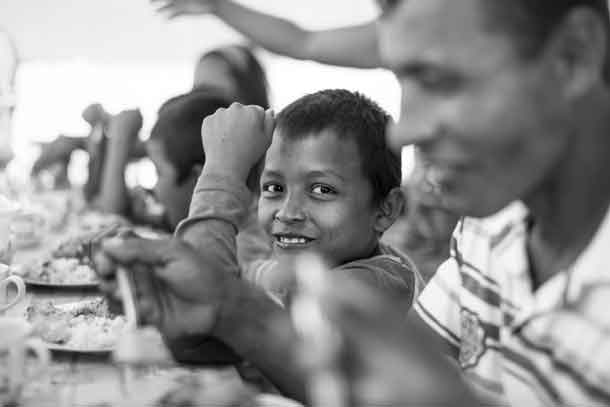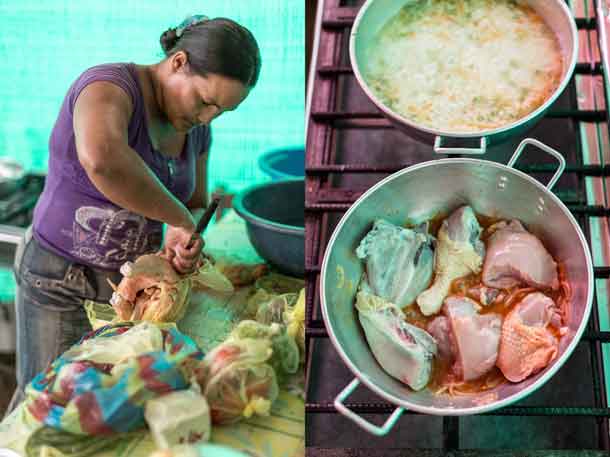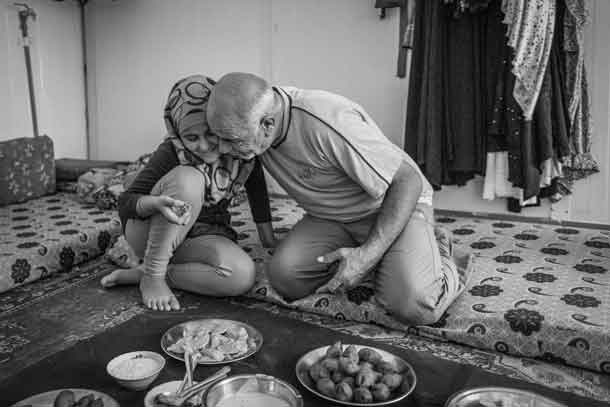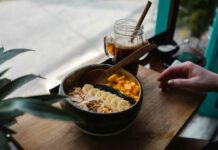
THUNDER BAY – LIVING – (Zester Daily) – Part of what makes eating together so pleasurable, in any language or culture, is the conversation. But when London-based photographer Chris Terry was in Niger photographing an ordinary family enjoying a spaghetti dinner, he was surprised that no one spoke.”It’s a great privilege to have food to eat,” explained the grandmother, the head of the household. “It’s not the moment to chat and say silly things.”
The spaghetti had been paid for with vouchers from the United Nations World Food Program (WFP). Under the program, Terry had been invited into the family’s home to document what has become the photo exhibit, “The Family Meal: What Brings Us Together.”
Terry photographed families receiving WFP assistance as they made and ate meals in five countries — Chad, Niger, Myanmar, Jordan and Ecuador — where hunger has become entrenched because of disasters and conflicts largely forgotten by the rest of the world. Chad and Niger have suffered the worst drought in 50 years; Myanmar families have been uprooted because of ethnic conflict; and Syrian and Colombian refugees have fled into Jordan and Ecuador, respectively, to escape violence in their own countries.
The exhibit first opened in 2014 at Gare du Midi in Brussels, Belgium, and has since traveled throughout Europe finishing last summer at the Milan Expo. (Learn more at http://familymeal.eu/whats-on.html).
Evin Joyce of WFP’s Brussels office came up with the Family Meal idea to promote the group’s message with positive, personal images from around the globe. Eating together is a ritual we all have in common, he explained. Gathering, preparing, cooking and sharing food, as a family, are activities humans have done for millennia.

Every year food from the WFP travels through often rough, hostile terrains to reach more than 90 million beneficiaries in 75 countries, via plane, train, truck, river barge, camel and yak. The idea of the family meal was especially poignant when the WFP faced five high-level crises simultaneously: South Sudan, Central African Republic, the Syria and Iraq conflicts, and West Africa’s Ebola outbreak.
During the exhibit’s appearance at the European Parliament, WFP Executive Director Ertharin Cousin said that the Family Meal photos “give a face to those we serve.”

The photos also give us a peek into the lives and meal traditions of families struggling in ways many of us cannot image. But to my surprise, many of the images made me feel, not pity, but delight — even a bit of envy, because we who do not suffer from hunger sometimes claim we are “too busy” for family meals.
The photos capture the intimacy and joy of eating together, no matter how desperate the circumstances. Food not only nourishes us; sharing it lifts our spirits. The homemade dishes shown are colorful and inviting, made with staples such as rice and sorghum flour, and enlivened with the flavors, textures and colors of achiote powder, yucca and pomegranate seeds. The food was often prepared over open fires, in family or communal kitchens. Families ate together, indoors and out, seated on cushions on the floor, on the ground or at tables crowded with relatives.
The winners of a recent Family Meal photo competition, judged by celebrity chef Jamie Oliver and photographer Terry, were also announced during the launch at the Parliament. In one photo, a family in the Philippines shares a meal by candlelight because of power outages that still occur after a devastating typhoon in 2012. As Terry commented, the image “draws the viewer in, emphasizing the human need to gather around light, and company, when sharing a meal.”
Guests at the Parliament launch were offered samples of the five featured recipes. We commented on all the spicy and varied flavors as we guessed at the ingredients. I was particularly delighted with the texture of the yucca root in the “Sweaty Chicken” dish. The yucca flower is the official “state flower” of my home state of New Mexico, but I had never tasted yucca root before.
Abu Sayid and his family hope that peace returns, so they can leave Jordan’s Zaatari refugee camp and go home to Syria. Credit: Chris Terry
For Syrian refugee Abu Sayid, who lives with his family in Jordan’s Zaatari refugee camp, preparing and eating traditional recipes with his family keeps alive his memories of home. During Terry’s photo shoot, he helped his wife prepare two staple Syrian dishes: kubbeh (bulgur wheat balls stuffed with mincemeat and onions) and shishbarak dumplings (thin dough with mincemeat filling cooked in a yogurt stew).
“WFP vouchers allow us to get any food we need from stores around here [the refugee camp],” Abu Sayid said in a WFP interview as he sealed a kubbeh ball and his wife started frying the first batch of dumplings. “In Syria, we like to laugh and joke during a meal. It makes the food more enjoyable.”
In Myanmar, the WFP’s Joyce asked one family why they eat together? “It gives us a sense of unity,” one of them replied. Food is our priority, another woman told him. “As long as we housewives have a bag of rice, the rest can sort itself out.”
Joyce also noticed that women put a lot of effort into preparing and flavoring meals, no matter how basic the ingredients. And like mothers everywhere, they sometimes had to remind their children, “Eat your vegetables.”
Pollo Sudado (Sweaty Chicken) from Ecuador
Prep time: 15 minutes
Cook time: 25 to 30 minutes
Total time: 40 to 45 minutes
Yield: About 8
Ingredients
1 whole chicken
2 onions
3 cloves of garlic
Oil
1 big tomato
Coriander, salt and pepper
1 tablespoon of achiote powder (annatto)
Directions
1. Rinse the whole chicken and chop it into pieces, taking off the legs, breast and wings.
2. Chop the onions and garlic and fry them with oil over a high flame in a large pan.
3. Add the tomato and let it simmer a bit.
4. Add the chicken and then lower the flame.
5. Add the coriander, salt, pepper and achiote powder.
6. Add a little water, cover the pot and leave it to simmer for 20 minutes.
Notes
Pollo Sudado should be served with rice and yucca, which should be peeled, chopped and boiled with salt for 20 minutes. ¡Buen Provecho!
Copyright 2016 Diane Fresquez via Zester Daily and Reuters Media Express






